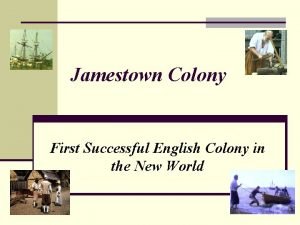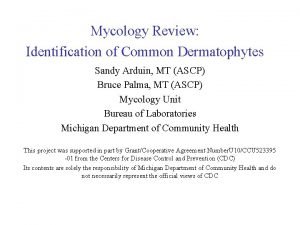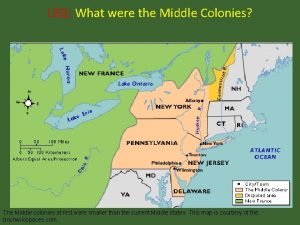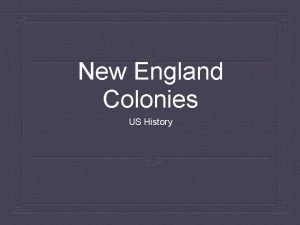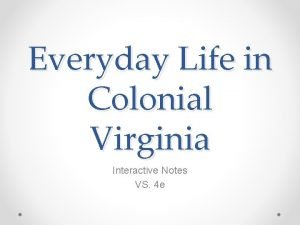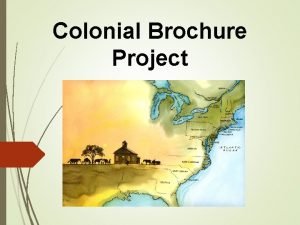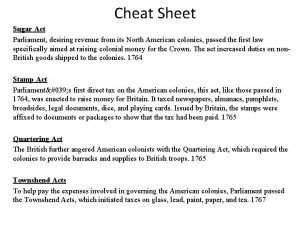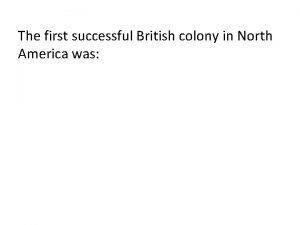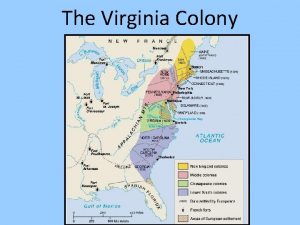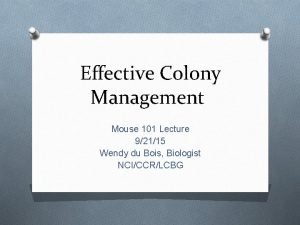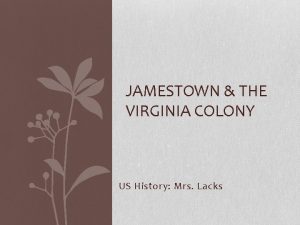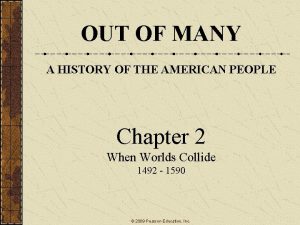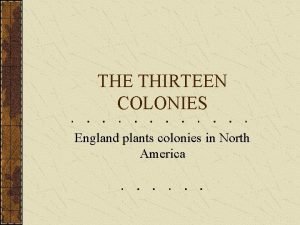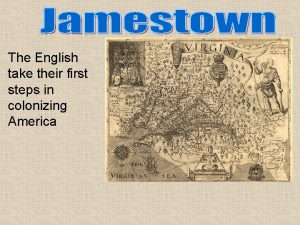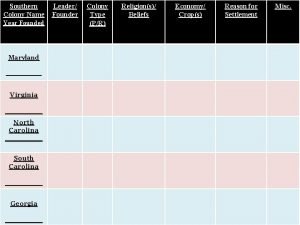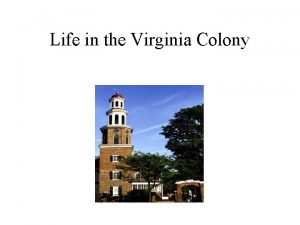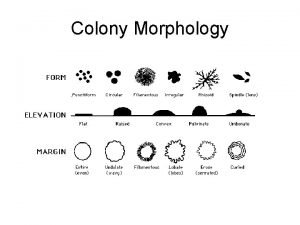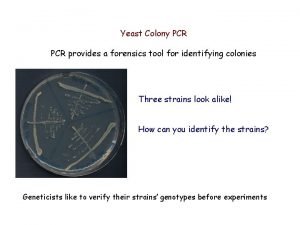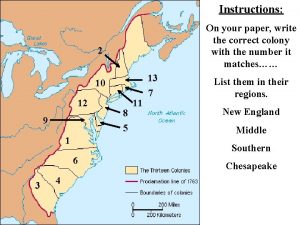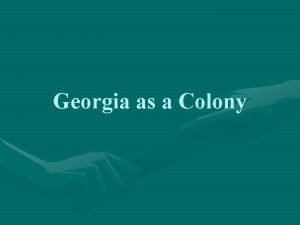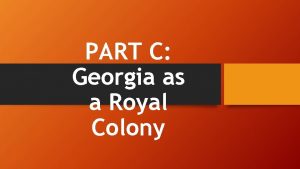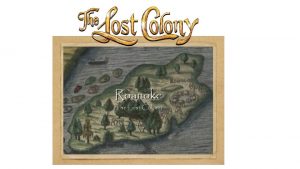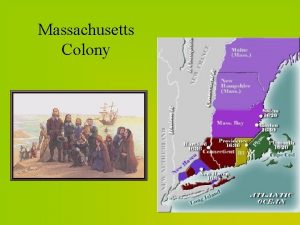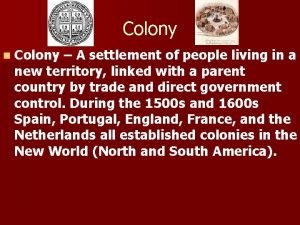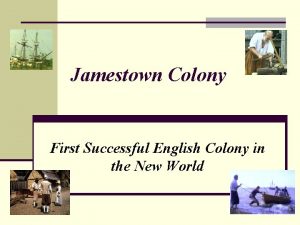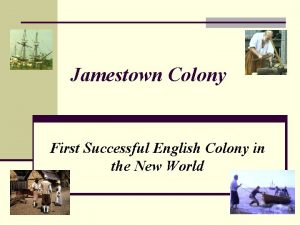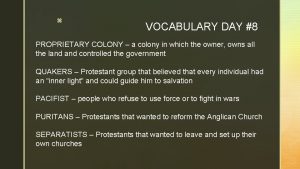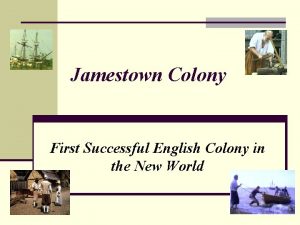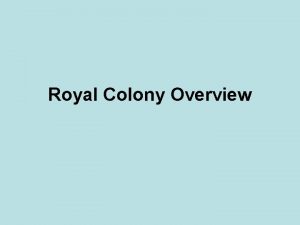Georgia as a colony SS 8 H 2





































- Slides: 37

Georgia as a colony SS 8 H 2 Analyze the colonial period of Georgia’s history.

SS 8 H 2 Analyze the colonial period of Georgia’s history. • a. Explain the importance of the Charter of 1732, including the reasons for settlement (philanthropy, economics, and defense). • b. Analyze the relationship between James Oglethorpe, Tomochichi, and Mary Musgrove in establishing the city of Savannah at Yamacraw Bluff. • c. Evaluate the role of diverse groups (Jews, Salzburgers, Highland Scots, and Malcontents) in settling Georgia during the Trustee Period. • d. Explain the transition of Georgia into a royal colony with regard to land ownership, slavery, alcohol, and government. • e. Give examples of the kinds of goods and services produced and traded in colonial Georgia

SS 8 H 2 Analyze the colonial period of Georgia’s history. • a. Explain the importance of the Charter of 1732, including the reasons for settlement (philanthropy, economics, and defense).

James Oglethorpe • James Oglethorpe was a wealthy, well -educated member of England’s Parliament. • Was upset with the harsh conditions of the average English citizen, especially those in debt • Believed all people were good, it was society that corrupted them • Oglethorpe worked to improve the quality of life for these citizens.

James Oglethorpe • In 1720 he started talking about a colony for England’s poor & unemployed • In 1730 he asked King George II for a charter of land • In 1732 King George gave him the charter for the colony of Georgia & named him as 1 of the 21 trustees

Trustees • Group of 21 Englishmen responsible for establishing and managing the new colony of Georgia • (Think board of directors)





Charter of 1732 • The charter of 1732 outlined the 3 reasons for settling Georgia • Philanthropy (Charity) • 50 acres of land given freely (500 if you paid your own passage), and 1 year’s supply of food, seed and agricultural supplies • Economics • Mercantilism- specifically W. R. I. S. T. crops • Wine, Rice, Indigo, Silk, and Tobacco • Defense • Georgia was created as a buffer colony to protect South Carolina (very profitable colony) from Spanish Florida

Charter of 1732 (Continued) • Trustees couldn’t: • Own land, hold office or be paid (for being a Trustee) • Requirements: • Colonists had to defend the colony • Things banned: • • • Selling/ buying land Rum (hard alcohol) & Liquor dealers Slavery Catholics Lawyers (according to some historians)

SS 8 H 2 Analyze the colonial period of Georgia’s history. • b. Analyze the relationship between James Oglethorpe, Tomochichi, and Mary Musgrove in establishing the city of Savannah at Yamacraw Bluff.

Tomochichi • Chief of the Yamacraw Indians • Created from Creek & Yamasee Indians in 1728 • Allowed Oglethorpe to settle on Yamacraw Bluff (future home of Savannah) • Helped advise him on Indian affairs & relations with the Spanish • Developed a strong friendship with Oglethorpe the rest of his life


Mary Musgrove • Half Creek/ half English • Could speak both languages & understood both cultures • Was KEY in Georgia’s success • She acted as a negotiator, mediator and interpreter for Oglethorpe from 1733 -1743 • Taught Oglethorpe: • How to trade fairly • Assisted them in opening several trading posts


Savannah • The first settlement established in Georgia in 1733 • Savannah was the first preplanned city • Designed by Oglethorpe • Each neighborhood, square, and garden lot was of equal size. • This design allowed for fair land distribution



SS 8 H 2 Analyze the colonial period of Georgia’s history. • c. Evaluate the role of diverse groups (Jews, Salzburgers, Highland Scots, and Malcontents) in settling Georgia during the Trustee Period.

Jews • 42 Jews arrived in Georgia 5 months after Oglethorpe and his group landed at Yamacraw Bluff • Originally banned in the 1732 Charter Oglethorpe made an exception because one of the Jews was a doctor; Dr Samuel Nunes. • The colony lost 20 people including it’s only doctor to yellow fever


Salzburgers • German-speaking protestant refugees from present-day Austria. • Expelled by a Catholic monarch & allowed to settle by King George II, a German Protestant • Would eventually establish New Ebenezer • Only group to have success with silk • The Salzburgers were against slavery and remained loyal to the trustees


Highland Scots • Oglethorpe brought the Highland Scots to Georgia because of their reputation as the best soldiers in the world. • Given land near abandoned Fort King George and named their settlement Darien. • Fought in the Battle of Bloody Marsh - pushed the Spanish back into Florida and ended the Spanish threat. • Supported the ban on slavery



Spanish threat from Florida • Part of the War of Jenkins’ Ear (1739 -1748) – Spain v. England • The Spanish attacked St. Simons Island were defeated by the Oglethorpe’s forces (colonists, Highland Scots, and Indian allies) • Called the Battle of Bloody Marsh • The Spanish eventually retreated to Florida and were no longer a serious threat to Georgia.


Malcontents • The term used to describe the colonists who were unhappy with the trustees’ regulations • Most of them had paid their own way to Georgia and were not reliant on the trustees for help. • Their main complaints were: • Limits on land ownership • Ban on rum/alcohol • Ban on slavery – the biggest complaint • After 10 years of malcontents’ complaints, the trustees allowed slavery and changed land ownership rules in 1751.


SS 8 H 2 Analyze the colonial period of Georgia’s history. • d. Explain the transition of Georgia into a royal colony with regard to land ownership, slavery, alcohol, and government. • e. Give examples of the kinds of goods and services produced and traded in colonial Georgia

Land Ownership & Alcohol • Rules relaxed for land • • Women could own land Land could be purchased New settlers claimed the western frontier (“crackers”) More settlers → Improved Economy → Bigger colony • Alcohol ban no longer enforced by 1742 • Repealed in 1749 by Parliament

Slavery • Wanted by colonists to compete with South Carolina • Originally outlawed it was allowed in 1749 • From 1750 - 1775, the number of slaves increased from 500 to 18, 000 • Had no rights at all, would be punished for broken rules • Helped increase agricultural production, especially rice

Government • After the colony was returned to the king he repealed Trustee laws and used Royal Governors to govern Georgia. • John Reynolds (1754 -1757) • Henry Ellis (1757 -1760) • James Wright (1760 -1776)

W. R. I. S. T. Crops • Wine- Not enough quantity; Not a success • Rice- 1 st staple crop; Became even more successful when slavery was introduced • Indigo- Successful however indigo production was harmful • Silk- Didn’t return desired profits; Not a success • Tobacco- Became even more successful during royal period
 Who governed the royal colony of georgia?
Who governed the royal colony of georgia? Crown or colony cheat sheet
Crown or colony cheat sheet Fosdick test
Fosdick test Draughtsman colonies
Draughtsman colonies The oneida colony declined due to
The oneida colony declined due to The first successful english colony was
The first successful english colony was The lost colony of roanoke
The lost colony of roanoke Microsporum nanum
Microsporum nanum River
River Who was this
Who was this Massachusetts bay colony
Massachusetts bay colony Everyday life in colonial virginia
Everyday life in colonial virginia Heliocentric vs geocentric venn diagram
Heliocentric vs geocentric venn diagram Middle colonies brochure
Middle colonies brochure Filo cnidaria classes
Filo cnidaria classes Was south africa a dutch colony
Was south africa a dutch colony For crown or colony cheat sheet
For crown or colony cheat sheet The first successful british colony in north america
The first successful british colony in north america Snyder agar test
Snyder agar test Jamestown advertisement
Jamestown advertisement What are the middle colonies
What are the middle colonies Jax colony management system
Jax colony management system What was the first successful english colony
What was the first successful english colony Compare and contrast trustee and royal georgia
Compare and contrast trustee and royal georgia Colony morphology bacillus cereus
Colony morphology bacillus cereus Poached egg colony of corynebacterium
Poached egg colony of corynebacterium Virginia colony
Virginia colony Nucleic acid hybridization principle
Nucleic acid hybridization principle The lost colony of roanoke
The lost colony of roanoke Roanoke colony
Roanoke colony Aerobic colony count
Aerobic colony count Deleware colony economy
Deleware colony economy Map of the lost colony of roanoke
Map of the lost colony of roanoke Southern colonies founder
Southern colonies founder Virginia colony culture
Virginia colony culture Colony
Colony Yeast colony pcr
Yeast colony pcr Colony
Colony





